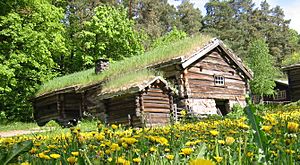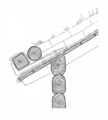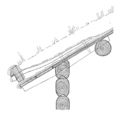Sod roof facts for kids

A sod roof, also known as a turf roof, is a special kind of roof that looks like a grassy field! It's a very old way of building roofs, especially in countries like Norway, Sweden, and Iceland in Scandinavia. Imagine a roof covered with real grass and plants – that's a sod roof!
These roofs were super common on traditional log houses in rural areas until the late 1800s. They were popular wherever people built with logs, like in Finland and the Scandinavian peninsula. Sod roofs are not just pretty; they are also great at keeping houses warm in cold weather because the thick layer of earth and plants acts like a natural blanket.
What is a Sod Roof?
A sod roof is a type of green roof. It's made by placing layers of sod (which is like a piece of grass with its roots and soil) on top of wooden roof boards. But here's a cool secret: the sod isn't what keeps the water out!
The real waterproof part of the roof is made of several layers of birch bark placed underneath the sod. Think of the birch bark as a natural raincoat for the house. The main job of the sod is to hold all those layers of birch bark in place and protect them. It also adds extra insulation.
Why is it Called a Sod Roof?
Even though the birch bark does the important job of keeping water out, the roof is called a "sod roof" because of its green, grassy look. In Scandinavian languages, it's called torvtak in Norwegian and Swedish, and torfþak in Icelandic. All these names mean "turf roof" or "sod roof," focusing on the visible green layer.
Images for kids
-
Sod roofs on farmhouses in Gudbrandsdal, Norway. Photo: Roede
-
Doukhobor house in Yefremovka, Georgia, with a sod roof
-
A more urban example in Tórshavn, capital of the Faroe Islands (autonomous territory of the Kingdom of Denmark).








